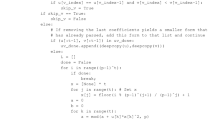Abstract
We establish the Hasse principle for systems of r simultaneous diagonal cubic equations whenever the number of variables exceeds 6r and the associated coefficient matrix contains no singular \(r\times r\) submatrix, thereby achieving the theoretical limit of the circle method for such systems.
Similar content being viewed by others
Change history
21 June 2023
A Correction to this paper has been published: https://doi.org/10.1007/s00208-023-02645-3
Notes
Henceforth we adopt the convention that zero entries in a matrix are left blank.
References
Atkinson, O.D., Brüdern, J., Cook, R.J.: Simultaneous additive congruences to a large prime modulus. Mathematika 39, 1–9 (1992)
Baker, R.C.: Diagonal cubic equations III. Proc. London Math. Soc. 58(3), 495–518 (1989)
Brüdern, J., Cook, R.J.: On simultaneous diagonal equations and inequalities. Acta Arith. 62, 125–149 (1992)
Brüdern, J., Wooley, T.D.: Hua’s lemma and simultaneous diagonal equations. Bull. London Math. Soc. 34, 279–283 (2002)
Brüdern, J., Wooley, T.D.: The Hasse principle for pairs of diagonal cubic forms. Ann. Math. 166(2), 865–895 (2007)
Davenport, H.: Analytic Methods for Diophantine Equations and Diophantine Inequalities, 2nd edn. Cambridge University Press, Cambridge (2005)
Davenport, H., Lewis, D.J.: Cubic equations of additive type. Philos. Trans. R. Soc. London Ser. A 261, 97–136 (1966)
Davenport, H., Lewis, D.J.: Simultaneous equations of additive type. Philos. Trans. R. Soc. London Ser. A 264, 557–595 (1969)
Gowers, W.T.: A new proof of Szemerédi’s theorem. Geom. Funct. Anal. 11(3), 465–588 (2001)
Heath-Brown, D.R.: The circle method and diagonal cubic forms. Phil. Trans. R. Soc. London Ser. A 356, 673–699 (1998)
Hooley, C.: On Waring’s problem. Acta Math. 157, 49–97 (1986)
Hooley, C.: On Hypothesis \(K^*\) in Waring’s problem. In: Sieve Methods, Exponential Sums, and their Applications in Number Theory (Cardiff, 1995), pp. 175–185. Cambridge University Press, Cambridge (1997)
Vaughan, R.C.: On Waring’s problem for cubes. J. Reine Angew. Math. 365, 122–170 (1986)
Vaughan, R.C.: A new iterative method in Waring’s problem. Acta Math. 162, 1–71 (1989)
Vaughan, R.C.: The Hardy–Littlewood Method, 2nd edn. Cambridge University Press, Cambridge (1997)
Wooley, T.D.: On simultaneous additive equations, II. J. Reine Angew. Math. 419, 141–198 (1991)
Wooley, T.D.: Sums of three cubes. Mathematika 47, 53–61 (2000)
Acknowledgments
The authors are grateful to the referees for the extreme care taken in reviewing this paper, and in particular for numerous suggestions which have clarified our exposition and prompted significant corrections.
Author information
Authors and Affiliations
Corresponding author
Additional information
The authors are grateful to the Hausdorff Research Institute for Mathematics in Bonn for excellent working conditions that made the writing of this paper feasible. The support of the Akademie der Wissenschaften zu Göttingen is also gratefully acknowledged.
Rights and permissions
About this article
Cite this article
Brüdern, J., Wooley, T.D. The Hasse principle for systems of diagonal cubic forms. Math. Ann. 364, 1255–1274 (2016). https://doi.org/10.1007/s00208-015-1249-1
Received:
Revised:
Published:
Issue Date:
DOI: https://doi.org/10.1007/s00208-015-1249-1



